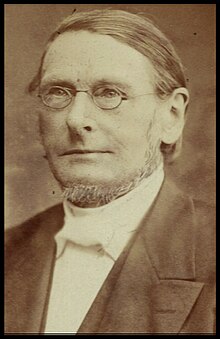Paul Sorrow
Paul Kummer (born August 22, 1834 in Zerbst ; † July 7, 1912 in Hannoversch Münden ) was a German Protestant clergyman, teacher and scientist who became famous primarily for his contributions to mycological nomenclature.
Life
Kummer worked as a private teacher from 1857 to 1863, then as a curate in Zerbst. From 1877 until his retirement he was pastor in Hannoversch Münden.
Earlier taxonomic classifications of cap mushrooms by the taxonomist Elias Magnus Fries determined only a few genera, with most of the species being assigned to the agaric mushrooms . These few species have been divided into a large number of "tribes". In his book Der Führer in die Pilzkunde , published in 1871 , Kummer placed the majority of the "tribes" of Fries in the status of a genus and established many of the names used to this day.
His botanical-mycological author's abbreviation is “ P.Kumm. ".
Works
- The Guide to Mushroom Science: Instructions for the methodical, easy and reliable determination of the fungi occurring in Germany: with the exception of mold and all too tiny slime and core fungi ; with 80 lithographic images. Zerbst: E. Luppe, 1871 doi : 10.5962 / bhl.title.50494 , 2nd edition 1882, volume 2, the microscopic mushrooms 1884
- The guide to liverworts and vascular cryptogams: (horsetail, bear moss, bullock, root crops) . Berlin, J. Springer 1875
- The Guide to Moss Studies: Instructions for the easy and safe identification of German mosses. Berlin, J. Springer 1891
- Cryptogamous character images . Carl Rümpler, Hannover 1878 doi : 10.5962 / bhl.title.5413 .
- German flower world in character images . Carl Rümpler, Hannover 1879 doi : 10.5962 / bhl.title.12175
- The moss flora in the area around Hann. Münden. In: Bot. Centralblatt 1889, 40: 65-72, 101-106; Kassel.
literature
- Jan Peter Frahm, Jens Eggers: Lexicon of German-speaking bryologists . Volume 1. 2001, p. 263.
Web links
- Paul Kummer in the Historical Index of Mycologists, Illinois Mycological Society. ( Memento from October 16, 2008 in the Internet Archive )
- Natural History Museum Kassel
Individual evidence
| personal data | |
|---|---|
| SURNAME | Grief, Paul |
| BRIEF DESCRIPTION | German Protestant clergyman, teacher and scientist |
| DATE OF BIRTH | August 22, 1834 |
| PLACE OF BIRTH | Zerbst |
| DATE OF DEATH | July 7, 1912 |
| Place of death | Hannoversch Münden |
